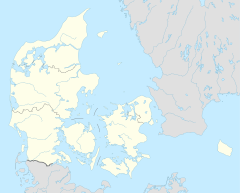Bernstorff Palace
| Bernstorff Palace | |
|---|---|
| Bernstorff Slot | |

Bernstorff Palace
|
|
|
|
|
| General information | |
| Type | Palace |
| Architectural style | Neo-Classicism |
| Town or city | Gentofte |
| Country | Denmark |
| Coordinates | 55°45′32″N 12°33′14″E / 55.75889°N 12.55389°E |
| Construction started | 1759 |
| Completed | 1765 |
| Client | Count Johann Hartwig Ernst von Bernstorff |
| Design and construction | |
| Architect | Nicolas-Henri Jardin |
Bernstorff Palace (Danish: Bernstorff Slot) in Gentofte, Copenhagen, Denmark, was built in the middle of the 18th century for Foreign Minister Johann Hartwig Ernst von Bernstorff. It remained in the possession of the Bernstorff family until 1812. In 1842, it was bought by Christian VIII. For many years, it was used as a summer residence by Christian IX until his death in 1906.
Since then and until recently, it was used by the Danish Emergency Management Agency as an academy for non-commissioned officers, but it has now opened as a hotel and conference centre.
The palace was designed by the French architect Nicolas-Henri Jardin, who had been brought to Denmark to complete Frederick's Church in Copenhagen after the death of Nicolai Eigtved in 1754. It is one of the earliest examples of Neoclassical architecture in Denmark. The elaborately decorated two-storeyed building was completed in May 1765 at considerable cost. At the time, it had four small decorative garrets, attics with decorative vases and a wide balcony on the roof ridge itself. On the garden side, there is a dome-covered projection rising the full height of the building.
The palace's many rooms were modest in size and intended primarily for domestic use rather than for display. Most are panelled with parquet floors, large mirrors and decorated ceilings. The four rooms on the south side have overdoors decorated by Johan Edvard Mandelberg.
Bernstorff left Denmark in 1770, after being dismissed by the regent, Johann Friedrich Struensee. The estate remained in his family’s hands until 1812 but was then sold on several occasions. It was about to be demolished in 1842 when Christian VIII bought it and charged Jørgen Hansen Koch with its comprehensive renovation. A mezzanine was added and the layout of the first-floor rooms was changed.
...
Wikipedia

